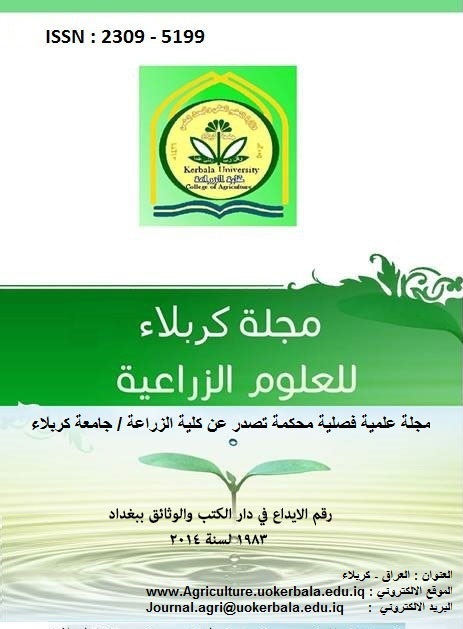The biological control on root-knot nematode meloidogyne spp on tomato by using some specis of bacteria Pseudomonas fluorescens , Azotobacter. chroococcum and Streptomyce sp
DOI:
https://doi.org/10.59658/jkas.v3i3.539Abstract
This study was conducted to isolate and identify some bacterial species from the soil surrounding the roots of some weeds Avena fatua L . and Raphanus raphanistrum L. and to test their antagonistic efficiency in the inhibition of egg hatching and the vitality of juveniles of root knot nematode Meloidogyne spp. in addition to their efficiency in some of growth parameters, severity of infection and root gall index in tomato plants.
Results showed the possibility of isolated bacteria to dissolve phosphorus and production of oxidase and chitinase enzymes as well as its ability to tolerate the salinity and liquefy gelatin in addition to its ability for transition movement. Laboratory results were indicated that P. flurescens, Azotobacter .chroococcum and Streptomyces spp. were effective in reducing the percentages of hatched nematode eggs, during 72 hours, that were 58.88, 37.46 and 45.50%, respectively.
It was also found that the percentage of egg hatching reached 64.07% upon using the bio-mixture that significantly differed from the control treatment that was 0.00%. The results of field trials showed that the treatment of seed witht the genaus of bacteria led to raise the percentage of germination in all treatments compared to the contro ltreatment that gave germination percentage of P. flurescens 85.0%, followed by treatment of the bio-mixture (83.3%), however no significant difference were observed between the P. flurescens treatment and the treatment of bio-mixture.
It was also noticed that the treatment with P. fluorescens gave less disease index (1.9%) followed by the treatment with bio-mixture (2.27) and then the bacteria Streptomyces spp., whereas the highest disease index (3.59%) was found when treating with the bacteria Azotobacter . chroococcum.. Results obtained in this study indicate the possibility of the use of aforementioned bacteria in integrated pest management programs to control the root gall disease in tomato.
Downloads
Published
How to Cite
Issue
Section
License
Copyright (c) 2016 Copyright (c) 2024 is the Author's article. Published by the Journal of Kerbala for Agricultural Sciences under a CC BY 4.0 license

This work is licensed under a Creative Commons Attribution 4.0 International License.
Licensing Terms
All articles are published under a Creative Commons License and will be directed to the Creative Commons Attribution 4.0 International License (CC BY 4.0) That permits use, distribution, and reproduction in any medium, provided the original work is properly cited. This license also allows the work to be used for commercial purposes.
Use by both non-commercial and commercial users
This content is licensed under a Creative Commons Attribution 4.0 International (CC BY 4.0) license, permitting use by both non-commercial and commercial users. Individual users may access, download, copy, display, and redistribute the articles to colleagues, as well as adapt, translate, and text- and data-mine the content, subject to the following conditions:
- The author's moral rights, including the right of attribution and the right to protect their work from derogatory treatment, are respected.
- Where content in the article is identified as belonging to a third party, users must ensure that any reuse complies with the copyright policies of the owner of that content.
- If the article content is reused for research or educational purposes, users should maintain a link to the appropriate bibliographic citation, including the DOI and a link to the published version on the journal's website.






